May 2024
The global power-to-gas market size is calculated at USD 38.34 million in 2025 and is forecasted to reach around USD 96.68 million by 2034, accelerating at a CAGR of 10.44% from 2025 to 2034. The Europe power-to-gas market size surpassed USD 13.80 million in 2025 and is expanding at a CAGR of 10.60% during the forecast period. The market sizing and forecasts are revenue-based (USD Million/Billion), with 2024 as the base year.
The global power-to-gas market size accounted for USD 35.80 million in 2024 and is projected to hit around USD 96.68 million by 2034, growing at a CAGR of 10.44% during the forecast period from 2025 to 2034. The growth of the power-to-gas market is driven by the increasing demand for electricity worldwide and the rising use of renewable energy sources.
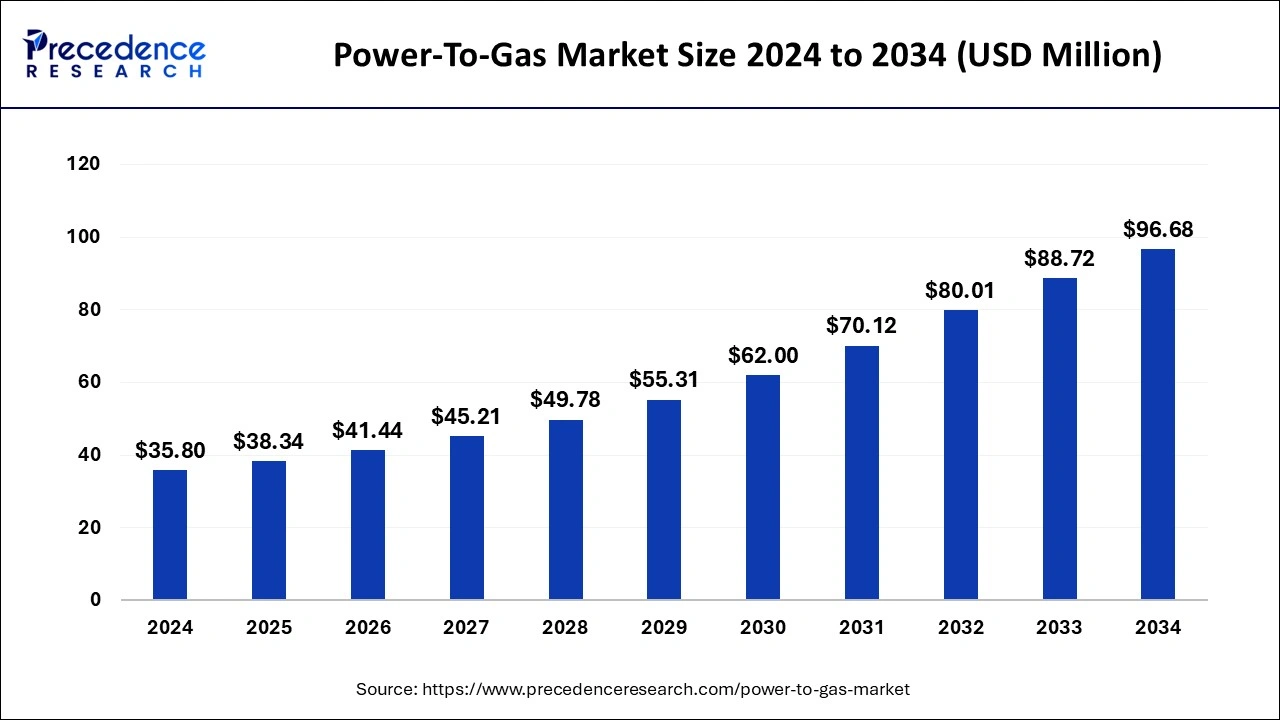
Artificial intelligence (AI) positively impacts the power-to-gas market. AI algorithms help in optimizing the operations of power-to-gas systems. These algorithms analyze data and monitor the system in real time. They also help control energy production and consumption, thereby increasing efficiency. Moreover, AI detects anomalies and predicts potential failures before they occur, which further reduces downtime.
The Europe power-to-gas market size reached USD 12.89 million in 2024 and is anticipated to be worth around USD 35.29 million by 2034, poised to grow at a CAGR of 10.60% from 2025 to 2034.
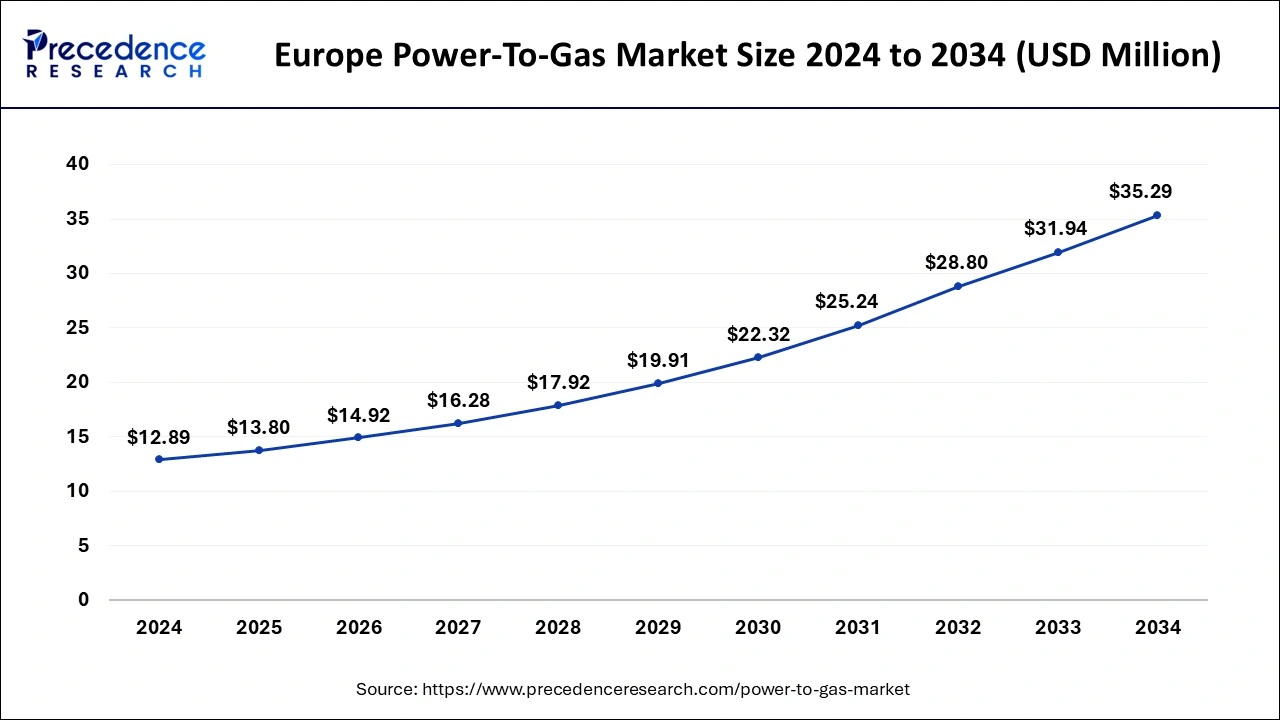
Europe region has held the highest revenue share of 36% in 2024. Some European nations, like Germany and Denmark, are in the midst of significant development of renewable electricity production, and it is anticipated that this will happen to a greater extent throughout Europe throughout the projected period. Low spot prices of electricity are anticipated to result from high power generation from intermittent sources. Additionally, it presents a chance for the creation of adaptable electro-intensive processes. Due to a number of programs and goals for integrating renewable electricity in Europe, power-to-gas has been technically validated at the pilot scale. In order to cut carbon emissions, the European energy sector is going through a significant transformation. The need for power-to-gas technology is anticipated to rise as a result of political RES integration and carbon reduction goals.
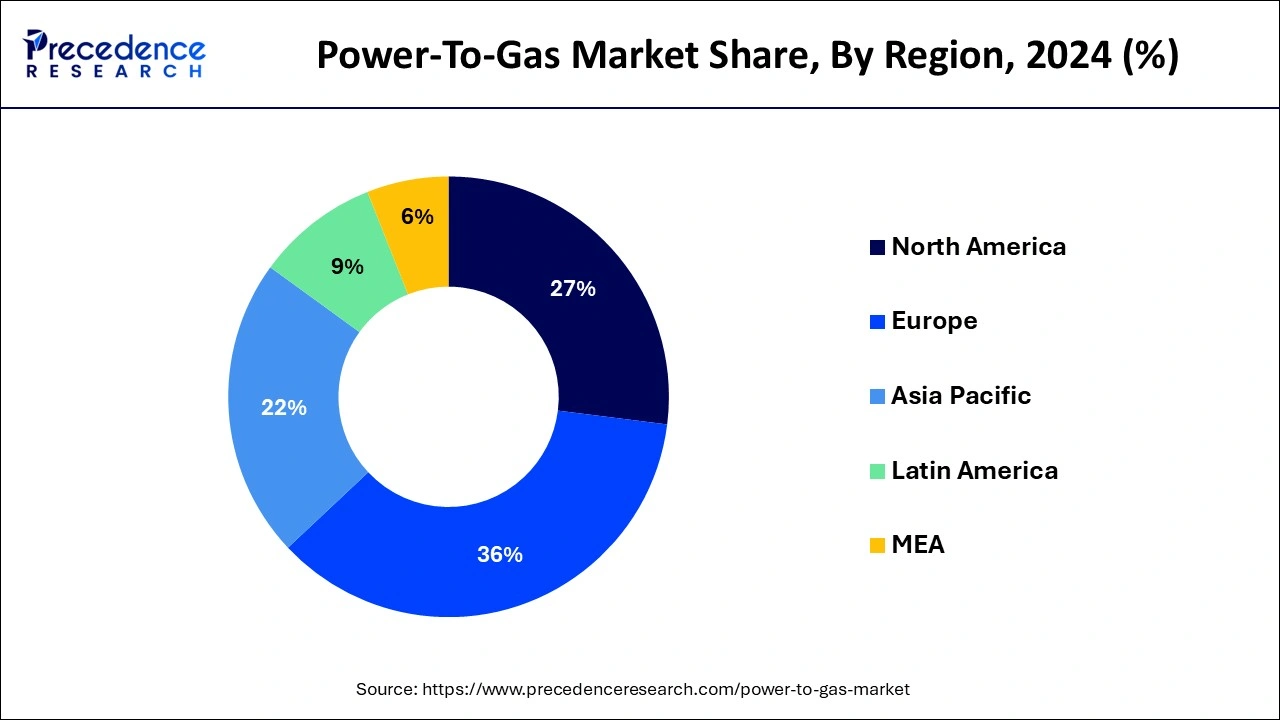
To create a sustainable future in the power-to-gas market, the region has implemented some of the highest environmental standards and aggressive climate policies in the world. The maintenance of environmental pollution, and climate change and reducing greenhouse gas emissions through effective renewable energy systems are top priorities.
The government policies of various countries are expected to cause the power-to-gas market in Asia Pacific to grow significantly. In addition, it is projected that the region's economic recovery from the COVID-19 epidemic will further fuel the rise of the power-to-gas business in the ensuing years.
A technique known as "power-to-gas" converts electrical energy into methane or hydrogen syngas (synthetic gas). The hydrogen produced by the power-to-gas industry is used by other businesses as a chemical or fuel. Energy from renewable resources like wind and solar is stored in power-to-gas systems and used for a variety of uses. These systems utilize stored energy for transportation, heating, and industrial applications. The power-to-gas industry's operations are a positive step toward combining renewable resources with electricity-generating sources.
Growth in the demand for renewable hydrogen, which may lower carbon emissions in a range of different industries, is predicted to be the main factor driving the market's expansion. The primary element fueling the industry's expansion is the decline in the cost of electrolyzing technology. According to the International Energy Agency, electrolyze stacks represent between 50 and 60 percent of the capital investment. The remaining 40 to 50 percent of the investment is made up of components for the plant, power electronics, and gas conditioning. Global demand for power will increase due to population and economic expansion.
| Report Coverage | Details |
| Market Size in 2025 | USD 38.34 million |
| Market Size by 2034 | USD 96.68 million |
| Growth Rate from 2025 to 2034 | CAGR of 10.44% |
| Largest Market | Europe |
| Base Year | 2024 |
| Forecast Period | 2025 to 2034 |
| Segments Covered | By Technology, By End User, and By Capacity |
| Regions Covered | North America, Europe, Asia-Pacific, Latin America, and Middle East & Africa |
The electrolysis segment dominated the market with the largest share of 70% in 2024. This is mainly due to its enhanced efficiency in converting excess renewable energy into hydrogen. Due to the increased awareness about the negative impact of greenhouse gases, there is a high demand for green fuel, bolstering the segmental growth.
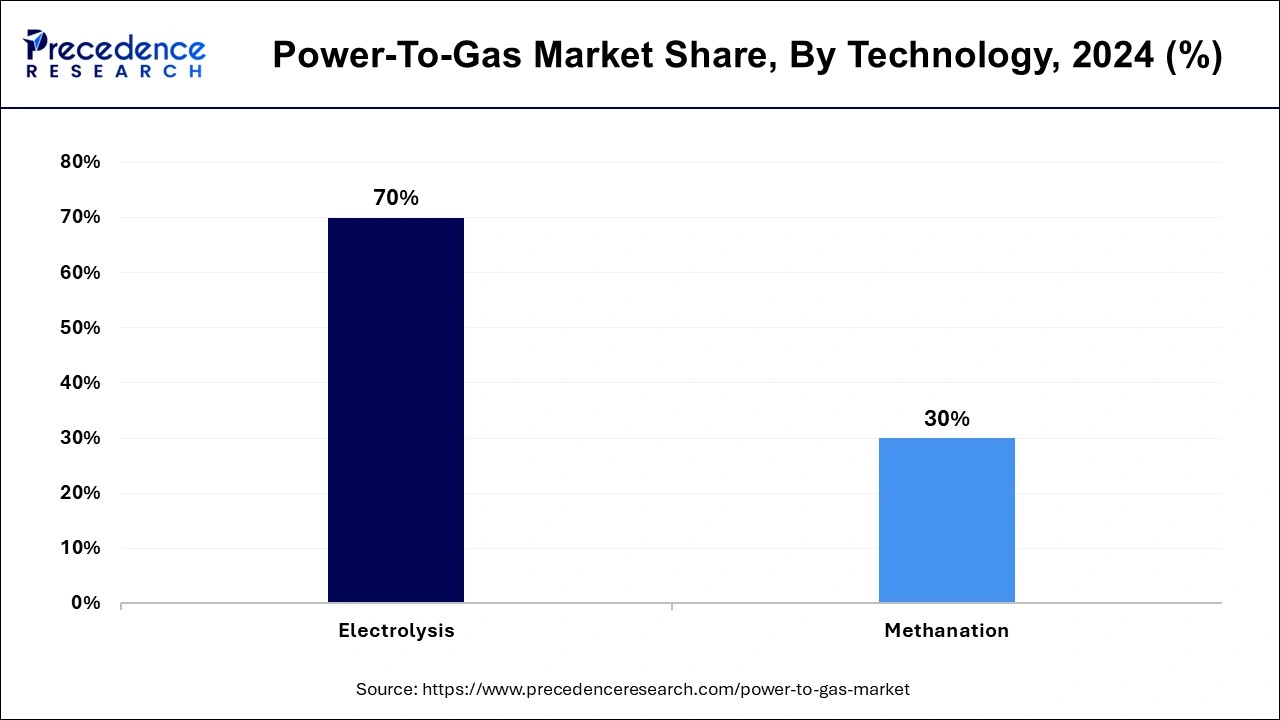
Because of the increased usage of renewable energy sources and the need to reduce carbon emissions, the segment is growing. Additionally, one of the elements propelling the segment's growth is the increasing need for fuel cells in electric vehicles. Since hydrogen produces fuel cells more efficiently and with fewer emissions, it is now used more frequently in manufacturing.
The Methanation segment is anticipated to witness rapid growth over the projected period. Methanation technology refers to the process whereby hydrogen and carbon dioxide are converted into methane. It builds on the existing physical infrastructure for natural gas and offers renewable energy storage. The compatibility with water and the possibility of using CO2 make methanation an important complementary process within the P2G value chain.
The commercial segment is expected to expand at a rapid pace over the projected period. Power-to-gas technologies are used in businesses to convert excess renewable energy into hydrogen or methane, reduce carbon emissions, and adhere to rules and policies. The chemical process, refinery, and steel manufacturing industries are known to harness a considerable amount of hydrogen. These industries are currently making significant efforts to reduce carbon generation and shift to cleaner manufacturing techniques. However, P2G technologies present the most suitable option for on-site hydrogen generation. There is also a growing demand for localized storage solutions due to concerns over energy security and uncertainty of prices.
The less than 100 kW segment accounted for the largest market share in 2024. The drivers for the power-to-gas market of less than 100 kW through methanation comprise decentralized and integrated renewable energy systems. These small capacities enable efficient conversion of carbon dioxide and hydrogen into synthetic methane, making them attractive for local energy applications.
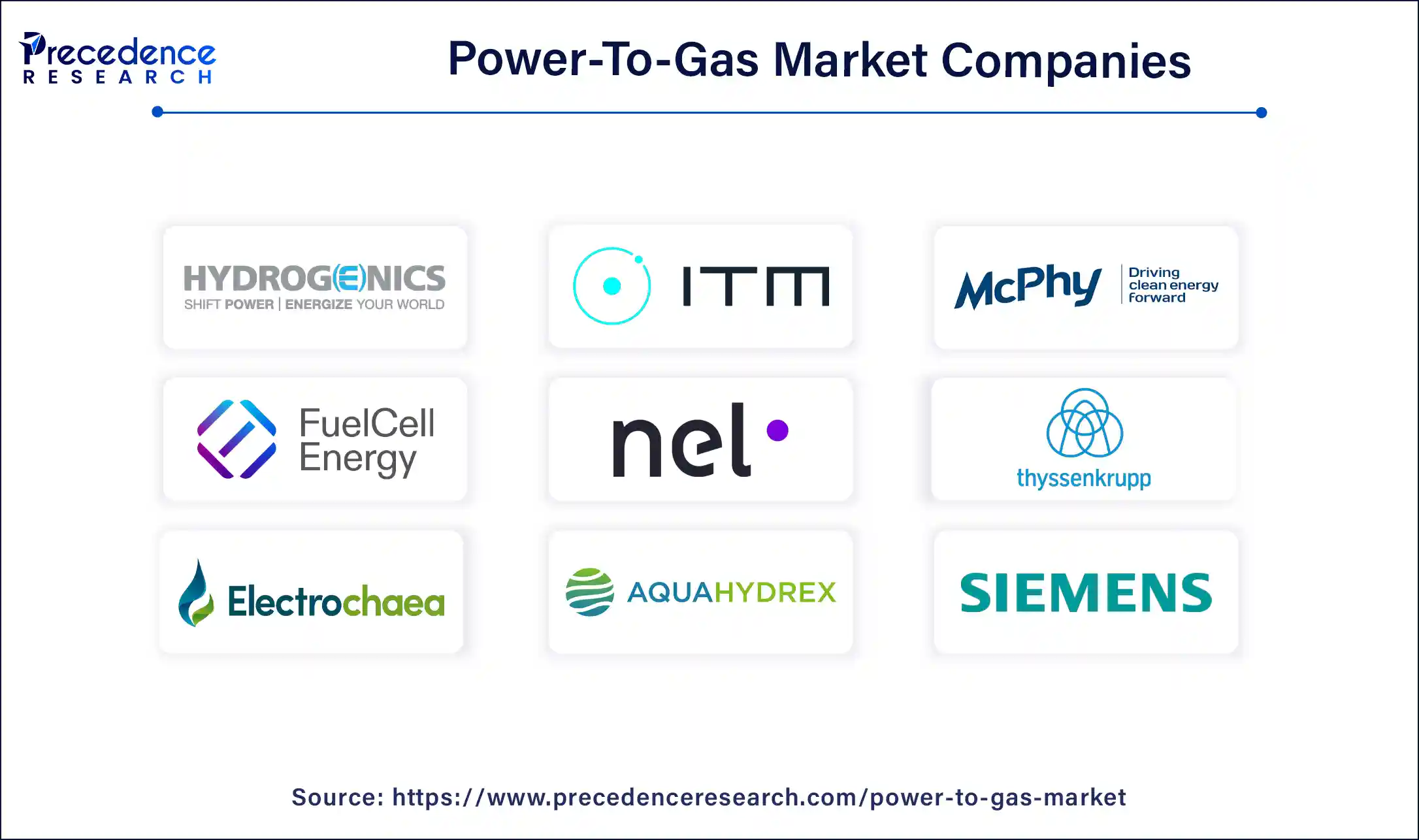
In November 2023, Nature Energy and Andel inaugurated a new power-to-gas facility in Denmark. The companies have invested in a biological Power-to-X plant located in Glansager. Once fully operational, the plant will produce hydrogen that will enhance Nature Energy's green gas output by 12,000 m³ per day.
By Technology
By End User
By Capacity
By Geography
For inquiries regarding discounts, bulk purchases, or customization requests, please contact us at sales@precedenceresearch.com
No cookie-cutter, only authentic analysis – take the 1st step to become a Precedence Research client
May 2024
September 2024
September 2024
January 2025